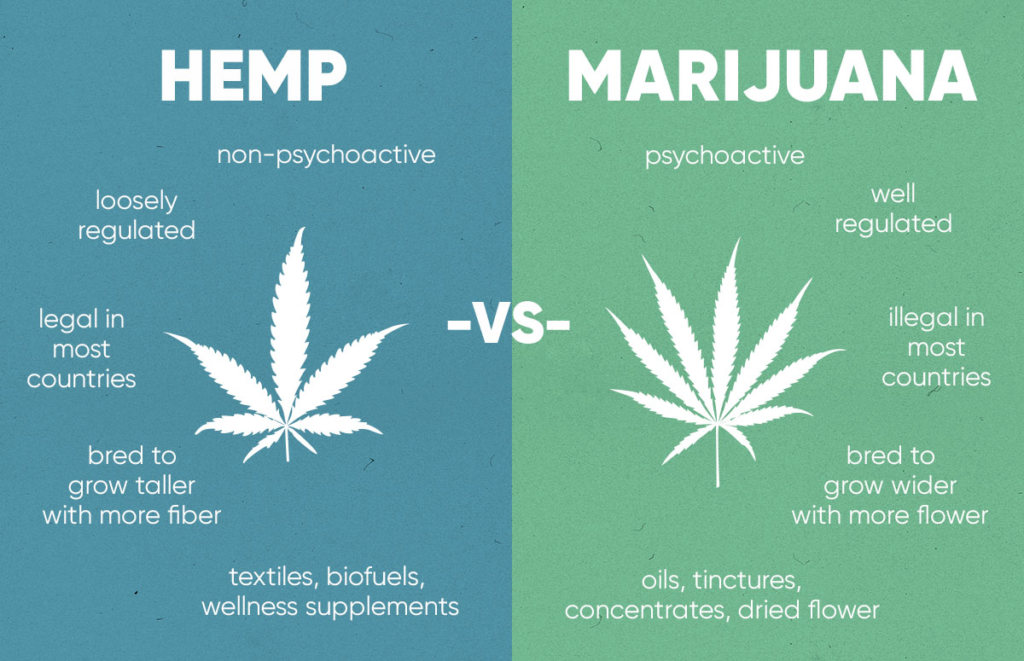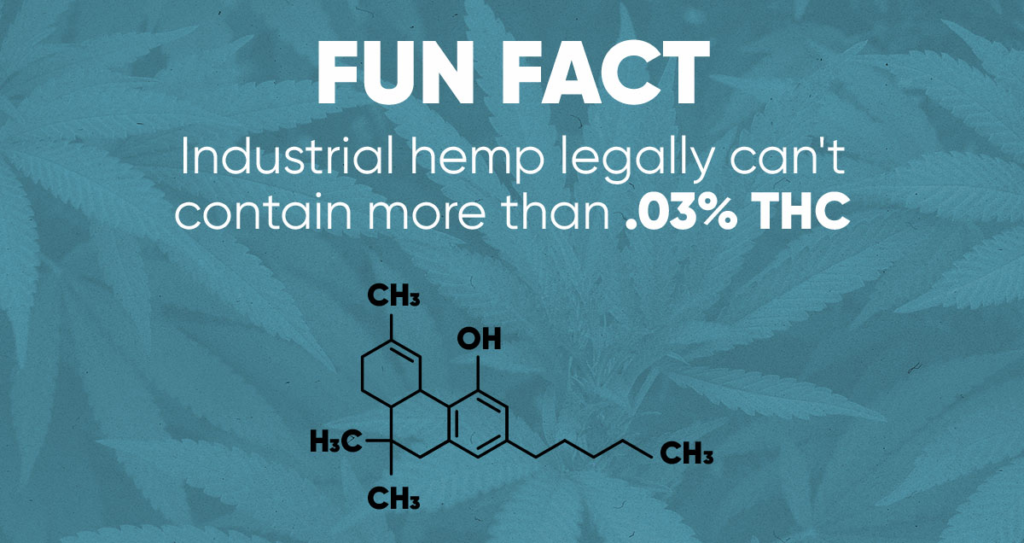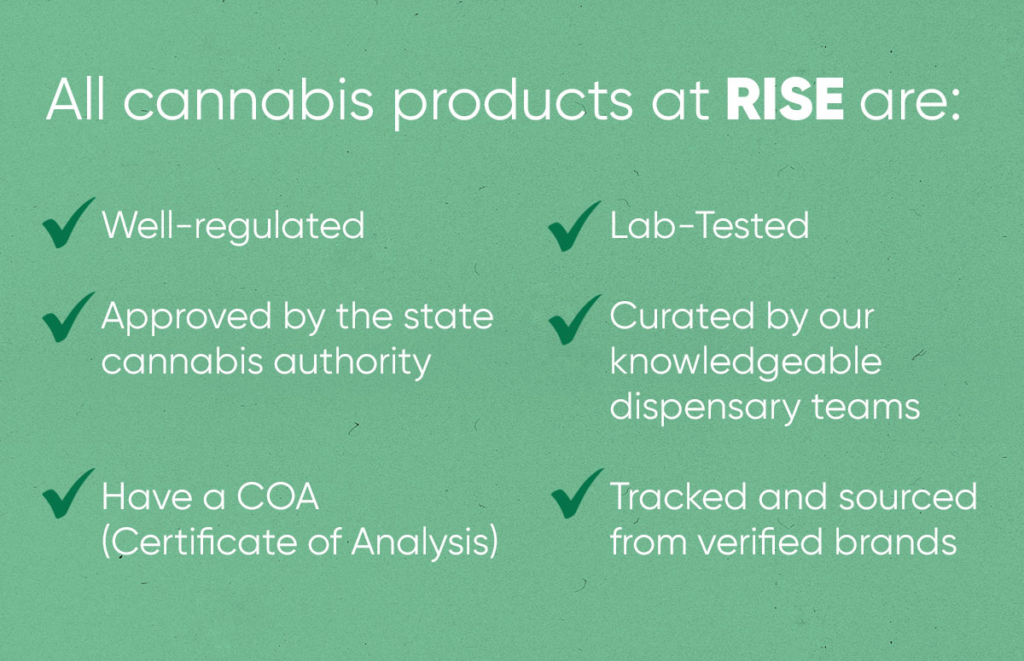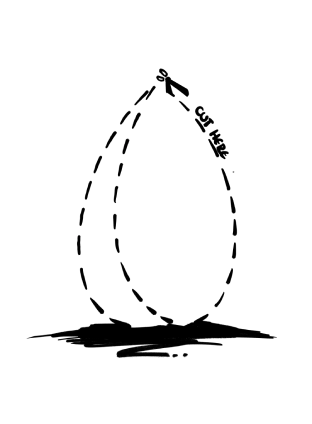Summary
- Hemp and marijuana are two varieties of the same basic plant: Cannabis sativa: they look different, grow differently, and have different uses and benefits.
- Hemp, also called industrial hemp, is legal to grow in the U.S., but only a few states have operating industrial hemp growing programs that fit USDA guidelines.
- Both hemp and cannabis can produce CBD products, but hemp has very low levels of THC (tetrahydrocannabinol), less than 0.3%.
- Marijuana is the term generally used to refer to cannabis that contains higher levels of THC, which produces a psychoactive effect.
- Hemp, aka industrial hemp, is grown and used to produce textiles, nutritional supplements like hemp oil, biofuels, and even plastics.
Is marijuana the same as hemp? That’s a question our team hears regularly from guests and patients. The simple answer: no, it isn’t—however, hemp and marijuana both come from the same plant species, called Cannabis sativa l.
Hemp plants are a different cultivar than the marijuana plant, which means that although they’re the same species, the plants grow differently and have different properties. Cannabis is a general term referring to three types of marijuana plants that have psychoactive properties: Cannabis sativa, Cannabis indica, and Cannabis ruderalis. You’ve probably heard the words indica sativa, as well as Hybrid: crosses between the two varieties. The third type, ruderalis, isn’t as well-known or grown very often because it has low THC and isn’t suitable for industrial hemp uses. [Source]
Is hemp the same as marijuana or cannabis?
Sometimes people refer to cannabis with a high THC content as “hemp flower” but the hemp plant isn’t the same as cannabis or marijuana that contains high levels of THC. Hemp is the name for the industrial version of the Cannabis sativa plant that produces large, tall plants that are useful for fiber, food, clothing, and other goods.
Does hemp have THC?
Hemp, aka industrial hemp, does have some THC, but in such a low amount that it is unlikely to produce any euphoric effects. Hemp legally must have below 0.3% THC in order to be cultivated under USDA regulations.
What is the difference between hemp and marijuana?
The main difference between hemp and marijuana is that hemp legally can’t have more than 0.3% THC content. Whereas marijuana, whether it comes from Cannabis sativa or Cannabis indica, has much higher percentages of THC.
Depending on the cultivars and types of plants, indica or sativa marijuana plants tend to also have lower levels of CBD than industrial hemp plants. Over time, studies have shown that hemp plants have higher levels of CBD than cannabis plants like indica weed which have been bred for high levels of THC.

History of hemp
Hemp and cannabis have a long history worldwide, as well as in the United States. The first cannabis plants have been dated to 12,000 years ago in east Asia. No one knows for certain, but an international research team based at the University of Lausanne analyzed the genomes of 110 cannabis varieties, including wild plants and modern cannabis hybrids. They reported that “all current hemp and drug cultivars diverged from an ancestral gene pool … in China.” Flash-forward about 8,000 years, and about 4,000 years ago, the genetic evidence shows that farmers around the world started to focus on growing hemp plants for fiber, and cannabis plants for psychoactive effects, like THC. [Source]
Physically, hemp plants started to be cultivated to grow taller and produce more fibers. Cannabis plants for THC production started to be grown as branching plants, producing more flowers containing THC.
The plant was widely grown in the U.S. up until 1937 when it was included in the Marihuana Tax Act. This Act brought all kinds of cannabis cultivation to a halt. Just a short time later, World War 2 changed things. During the first part of the war, the U.S. imported hemp for rope and fiber from the Philippines. When the Japanese invaded the Philippines in 1942, suddenly hemp was cut off. U.S. farmers quickly planted 400,000 acres of industrial hemp to supply the war effort. But by 1945, the war was over and the crop was, once again, considered illegal and the fields were plowed or burned.
Between 1945 and 1970, hemp and cannabis were both illegal in the U.S. Planting, including hemp with low-THC, totally stopped, and so did research. But the Controlled Substances Act in 1970 closed down any hemp or cannabis growth and research. Marijuana along with industrial hemp was included as Schedule 1 drugs “with no currently accepted medical use and a high potential for abuse.”
Over time, the positive benefits of cannabis for medical use became better-known, despite legal prohibitions. In 1996, California became the first U.S. state to legalize cannabis for medical use. Gradually, the movement for the legalization of medical cannabis grew. More information about the potential benefits of cannabidiol (CBD) also emerged, in part due to the efforts of the parents of a young girl with severe epilepsy, Charlotte Figi. Their many-year effort to show that CBD could benefit childhood epilepsy led to the Food and Drug Administration (FDA) approving the first CBD-related drug, Epidiolex, in 2018. [Source]
Industrial hemp became legal to grow in research programs through the 2014 Farm Bill, and in 2018, Congress passed a new Farm Bill which allows all states to create legal industrial hemp programs. As of late 2021, 39 U.S. states and Washington, D.C. have legalized some form of medical marijuana use.

Composition
So, let’s talk about the two main types of the cannabis plant: hemp (industrial hemp) and marijuana/THC-containing cannabis (Cannabis sativa and Cannabis indica). What are they each made up of, and what are the real differences?
When looking at hemp versus marijuana, industrial hemp legally can’t contain more than .03% THC (tetrahydrocannabinol). It may or may not contain higher levels of cannabidiol (CBD) than THC-containing strains of marijuana. Each strain of industrial hemp and of high-THC marijuana can contain different terpenes and other cannabinoid compounds — as many as 500 different ones — in each plant.
Uses
Hemp and marijuana have different uses because of the way the plants grow and the compounds each contains in various amounts.
With less than 0.3% THC and potentially higher amounts of CBD (cannabidiol), hemp’s uses can be ropes and textiles, biofuels (like biodiesel), and nutritional or wellness supplements, some made from CBD, and others made from hemp oil.
With more than 0.3% THC and plants that contain less fiber than hemp varieties, marijuana’s uses are primarily psychoactive. Marijuana can be used recreationally or medically, and it can be processed into CBD and THC oils, tinctures, and concentrates, as well as smoked in dried flower form.
Marijuana Legalization
Industrial hemp has been legal to grow in the United States since 2018, but the 2018 Farm Bill specifies that each state needs to set regulations and create programs for its legal cultivation and sale. So, although growing industrial hemp is legal throughout the U.S., state laws differ and not all states have set up programs to register and regulate hemp growing.
Growers need to register with their state’s Industrial Hemp cultivation program to comply with the 2018 Federal Farm Bill and final ruling about how hemp should be grown, issued by the U.S. Department of Agriculture in January 2021.
At the federal level, marijuana, or Cannabis sativa with more than 0.3% THC content, is illegal in the United States. State-by-state legalization of medical marijuana has progressed to a total of 39 states with some form of medical cannabis allowed. A total of 19 states permit legal recreational use of marijuana, but it is still illegal to transport cannabis across state lines. All forms of cannabis are illegal in Idaho, Nebraska, and Kansas.

Hemp vs. cannabis
Although they’re different varieties of the same plant, hemp and cannabis have different uses, different amounts of CBD or THC, and are used differently. The plants have been grown for thousands of years around the world. Hemp has provided many types of fiber, food uses, oil, and biofuel for many years. Hemp can even be used to produce plastics. Cannabis has provided recreational use for thousands of years and is also associated with potential benefits for a variety of health conditions, which is why it has been adopted by various states in medical cannabis programs.
Hemp CBD vs. cannabis CBD
So, what’s the difference in marijuana derived CBD vs. hemp derived CBD? There actually isn’t any!
Once CBD is refined from a plant, there is no difference between CBD that comes from an industrial hemp plant and CBD that comes from a cannabis plant.
The main difference between the two sources is state and federal laws that govern how the plants are grown, or whether they’re legally grown in different states and localities. Industrial hemp tends to contain more CBD than high-CBD varieties of cannabis, which makes it a good candidate for manufacturers who are refining it for CBD to put into different products. You will find a lot of CBD products that are made from cannabis, however.
As more states institute industrial hemp growing programs, more CBD products could be made from industrial hemp as opposed to high-CBD/low-THC strains of “regular cannabis.”
Hemp plant vs. cannabis plant
Industrial hemp plants tend to grow taller than cannabis plants. Cannabis plants have been bred to spread wider and produce more flowers that contain THC. Industrial hemp plants have been bred to grow taller and have more fiber that can be processed into rope, textiles, and similar hemp products. Industrial hemp plants are also generally hardier than cannabis plants, and can also be grown close together in fields and harvested similar to grasses that are grown for fiber. Cannabis plants are grown farther apart instead of close together and can be carefully tended to produce the greatest amount of flowers.
Hemp oil vs. cannabis oil
You may hear people referring to CBD oil as hemp oil, but hemp oil is actually a nutritional and skin product that’s refined from the seeds of the cannabis plant. Cannabis seeds contain oil, but they don’t contain CBD or THC. CBD oil is made from cannabis stalks, leaves, and flowers. CBD oil can contain tiny or trace amounts of THC. Oil or tinctures made from the cannabis plant can contain either CBD or THC.
Source: Rise Cannabis.

